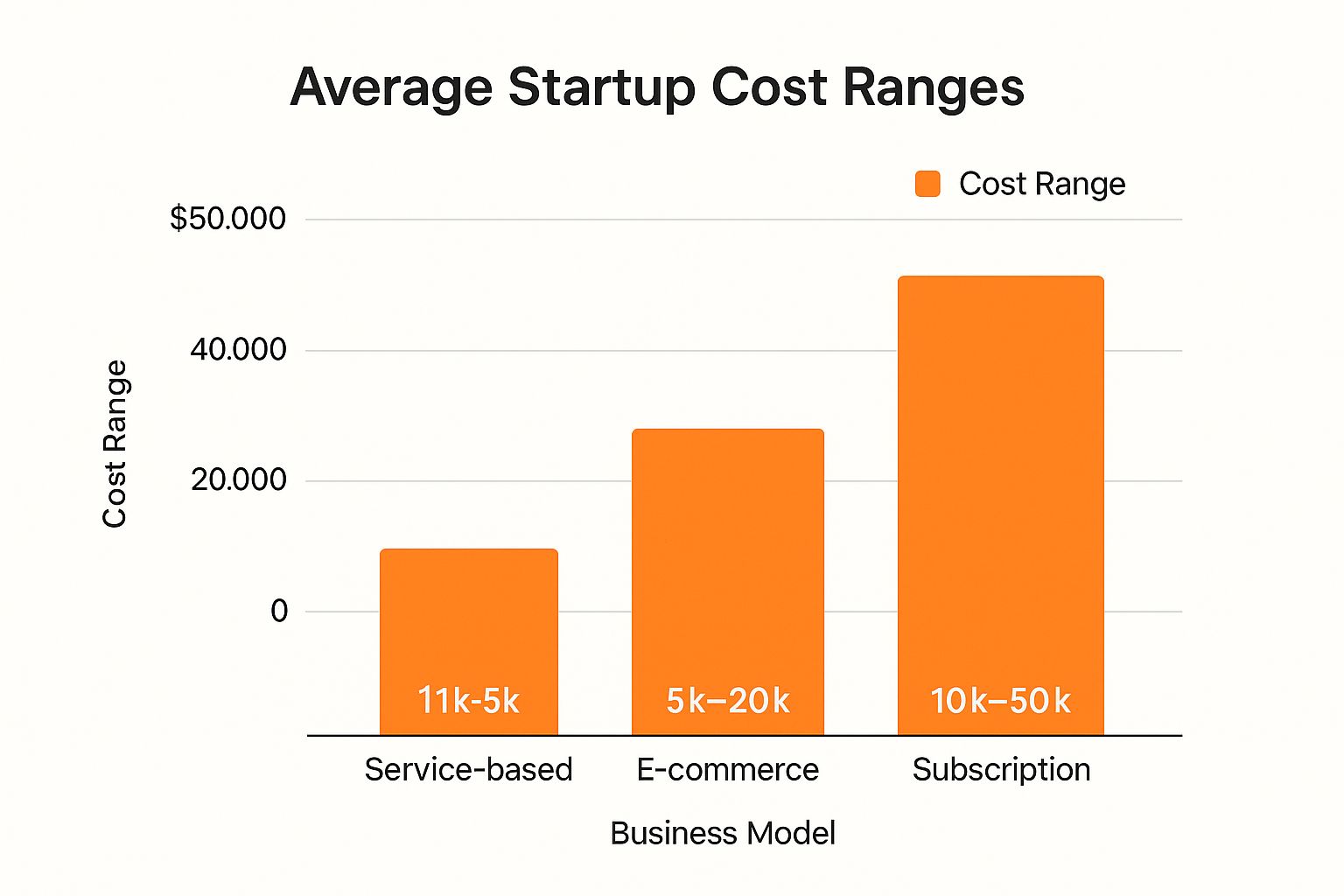Most entrepreneurs get it backward. They hunt for a trendy idea first, then try to cram themselves into the business model. This rarely works. The most durable, successful businesses I've seen are a natural extension of the founder. So, before you even think about market gaps, let's figure out who you are and what kind of business fits your life.
This isn't just fluffy self-help; it's the strategic foundation. When things get tough—and they always do—your genuine connection to the work is what will pull you through.
Aligning Your Business Idea With Who You Are
The first, most critical step is an honest look in the mirror. You're searching for the sweet spot where your skills, passions, and real-world limitations overlap. Think of this as building a personal filter. It will help you instantly discard ideas that are a terrible fit, saving you months of wasted effort.
Map Your Skills and Passions
Let's start by taking inventory. Your skills are what you can do, and your passions are what you'll keep doing when you're tired and facing setbacks. A business built on a skill you secretly hate is just a fast track to burnout.
Forget your job title for a minute and get specific:
- Hard Skills: Are you a wizard with Figma? Can you write Python scripts in your sleep? Maybe you're a master of SEO or have a knack for turning complex data into simple charts.
- Soft Skills: Are you the person everyone comes to for advice? A natural salesperson? Or maybe you excel at building communities or keeping complex projects on track. These are just as valuable.
- Deep Knowledge: What industry do you know inside and out from your day job or a lifelong hobby? Maybe it's the messy world of e-commerce returns, the regulations in healthcare, or the nuances of the indie gaming scene.
- Real Passions: What do you find yourself reading about on a Saturday morning? What problems in your own life do you constantly complain about? That's often where the best ideas are hiding.
Define Your Personal and Financial Boundaries
Now for a dose of reality. Every founder's situation is unique, and ignoring your personal and financial constraints is a critical mistake. Be brutally honest with yourself about your time, money, and risk tolerance.
Globally, there are over 150 million startups, with a staggering 50 million new ones popping up each year. That's a lot of ambition. But it's also a crowded field where resources are everything. With roughly 1 in 5 new businesses failing in their first year, often due to running out of cash, you need a plan that fits your reality. You can explore more on these global startup trends to get a sense of the competitive environment.
How much can you truly work on this each week? What's your financial runway—how many months can you survive before the business needs to pay you?
The goal isn't just to find a business idea; it's to find a business model that fits your life. A high-growth, venture-backed startup requires a different risk profile and time commitment than a bootstrapped SaaS or a solo consultancy.
To bring this all together, I’ve found that mapping these personal factors against potential business types is incredibly clarifying. This framework helps you see where your unique profile points you.
Self-Assessment Framework For Aspiring Founders
| Assessment Area | Guiding Questions | Example Business Fit |
|---|---|---|
| Your Core Skills | What am I exceptionally good at? What technical or soft skills do I already possess that people would pay for? | Expert Coder: SaaS product, developer tools. Great Writer: Niche content site, copywriting agency. |
| Your Genuine Passions | What topics do I obsess over for free? What problem in my own life would I love to solve? | Loves Fitness: A training app, a niche supplement brand. Home Organization Nerd: A professional organizing service. |
| Your Financial Runway | How much capital can I invest? How long can I go without an income? Am I looking for a side hustle or a full-time leap? | Low Capital: Service business (consulting, freelance). High Capital: E-commerce with inventory, hardware. |
| Your Time Commitment | How many hours per week can I realistically dedicate? Do I need immediate cash flow or can I build slowly? | <10 hrs/week: A niche blog, digital products. 40+ hrs/week: Agency model, venture-scale startup. |
| Your Risk Tolerance | Am I comfortable with the "all or nothing" nature of a VC-backed startup, or do I prefer a slow, profitable build? | Low Risk: Bootstrapped micro-SaaS. High Risk: A moonshot tech idea requiring significant R&D. |
Using this table helps you move beyond vague ideas and start homing in on a business archetype that actually makes sense for you. By aligning your business with your personal DNA, you're not just asking, "What business should I start?" You're asking a much more powerful question: "What business am I uniquely positioned to build and sustain for the long haul?"
Finding Real Problems People Will Pay To Solve
Forget about brainstorming the "next big thing" in a vacuum. The most durable businesses aren't born from abstract ideas; they're built on solving tangible, frustrating problems for real people. Your job as a founder isn't to be a visionary genius—it's to be a world-class problem hunter.
Honestly, some of the most successful founders I've met are just really good listeners. They pay attention when people complain.
The internet is a vast, echoing chamber of these complaints, and community platforms are where they're most raw and honest. Instead of guessing what people might want, you can literally find them spelling out what frustrates them, what tools they wish existed, and what pains they would gladly pay to make disappear.
Use Reddit as Your Idea Engine
When you're searching for a business to build, online communities are your unfair advantage. Think about it: platforms like Reddit host thousands of niche subreddits where professionals, hobbyists, and everyday consumers gather. They're there to share tips, ask for help, and—most importantly for you—vent.
For an indie hacker or a solopreneur, these threads are pure gold. You get direct, unfiltered access to the minds of your potential customers. A system administrator in r/sysadmin might post about a painfully clunky backup process. A small business owner in r/smallbusiness might lament how much time they waste managing invoices.
These aren't just complaints. They are business ideas, gift-wrapped and waiting for you. The challenge, of course, is that sifting through thousands of posts is a massive time sink. That’s where you need to get strategic.
Use a Dedicated Tool for Problem Discovery
Instead of doom-scrolling through forums hoping for a spark of inspiration, you can use a tool specifically designed to surface these problems for you. This is exactly what ProblemSifter was built for. It methodically scans specific subreddits to pull out the real, unfiltered problems people are actively trying to solve.
Here’s a quick look at how ProblemSifter organizes these validated problems, saving you from the chaos of endless Reddit feeds.

This dashboard is more than just a list. It provides the crucial context you need to start validating an idea immediately.
Unlike other tools, ProblemSifter doesn’t just suggest ideas—it connects you to the exact Reddit users asking for them. This means you get the problem, the original post, and a direct line to your potential first customers.
This direct connection is what truly sets this approach apart. It transforms a vague idea like "invoice software" into a concrete, actionable opportunity: "I see user 'SmallBizOwner123' needs a simple way to track partial payments on invoices for freelance projects." Now you have a specific person and a specific problem. You can learn more about this philosophy of how to find the problem before building the solution.
A Practical Framework for Finding Ideas on Reddit
You can apply this problem-hunting mindset to almost any niche you can think of. Here's a simple way to approach it:
- Identify Your Niches: Start with audiences you already understand. Are you a designer? Dive into
r/web_design. A marketer? Check outr/marketing. The more specific the community, the more targeted the problems will be. - Listen for High-Emotion Language: Keep an eye out for phrases like "frustrated," "annoyed," "is there a tool for," or "I wish there was an app that..." This is the language of genuine pain.
- Analyze and Automate: A tool like ProblemSifter does all the heavy lifting for you. It surfaces the most promising opportunities, saving you dozens of hours of manual work. You get a curated list, letting you focus on what really matters: building.
This method completely flips the traditional startup model. You begin with confirmed demand from a real person, not just a hunch in your gut.
And the investment is minimal. ProblemSifter offers lifetime access for a simple, one-time fee: $49 for one subreddit or $99 for three. No recurring subscriptions, no hidden costs. It's a ridiculously cost-effective way for bootstrappers to get straight to solving problems people will actually pay to fix.
Validating Your Idea Before You Build Anything
Before you write a single line of code or place that first inventory order, let's talk about the single biggest mistake I see new founders make: they build something nobody actually wants. An idea is just a guess, a hypothesis. Your job is to find out if the market agrees, and you can do that without spending a fortune.
The goal here isn't to build a product; it's to gather cold, hard evidence that a real problem exists and that people are willing to pay for a solution. This process is all about learning, not launching.
Start with Conversations, Not Code
Your first move shouldn't be designing a landing page or brainstorming ad copy. It should be talking to the people who are supposedly wrestling with the problem you aim to solve. I’ve found that generic surveys are almost useless here—they tell you what people think they’ll do, not what they actually do. Nothing beats a direct, one-on-one conversation for uncovering the truth.
This is where your earlier problem discovery work really shines. If you've used a tool like ProblemSifter, you're already way ahead of the game. It doesn't just give you abstract ideas; it gives you the Reddit usernames of people who have already detailed their frustrations in their own words.
For just $49, you get lifetime access to a curated list of real-world business problems. More importantly, you get a direct line to the very people experiencing that pain.
This is a complete game-changer for validation. Instead of shouting into the void on social media, you can send a targeted, personal message. Try something simple: "Hey, I saw your Reddit post about [specific problem]. I'm exploring a solution for that—would you be open to a quick 15-minute chat about your experience?"
That kind of outreach is infinitely more valuable than a generic tweet. To make sure you're asking the right questions, check out this excellent guide on customer discovery interview questions. It’ll help you structure those calls for maximum insight.
Run Low-Cost Market Tests
Once you've had a few promising conversations and have a better grip on the problem, it’s time to test your proposed solution with a slightly bigger audience. The trick is to simulate your offer without actually building it.
Here are a few powerful, low-cost methods I've seen work time and again:
The Simple Landing Page: Use a dead-simple tool like Carrd or a more robust one like Unbounce to spin up a one-page website. State your value proposition clearly, outline the benefits, and have one single call-to-action: "Join the Waitlist" or "Get Early Access." Your only job is to collect email addresses. Nothing more.
Small Ad Campaigns: Pick a platform where your audience hangs out—Reddit, LinkedIn, Facebook—and run a tiny, targeted ad campaign. Spend just $50-$100 to drive traffic to your landing page. You’re not just looking at clicks; you’re looking at the conversion rate. Are real people interested enough to hand over their email?
The Concierge MVP: This is my favorite "fake it 'til you make it" strategy. Instead of building software, you deliver the service manually. For instance, if your idea is an AI tool that writes social media posts, you would personally write the posts for your first few customers and email them the results. This is the ultimate test of your core value proposition and provides incredible, raw feedback.

Analyze the Results Honestly
After running your tests, you have to be brutally honest with yourself. A few email sign-ups from your mom and your best friend don't count as validation. You're looking for genuine interest from total strangers who fit your ideal customer profile.
Here’s a simple way to think about the signals you're getting:
| Validation Signal | What It Looks Like | What It Means |
|---|---|---|
| Weak Signal | Likes on a social media post, positive comments from friends. | Mild interest, but zero commitment. This is not a buying signal. |
| Medium Signal | Email sign-ups on a waitlist, positive feedback from cold DMs. | People are intrigued enough to want to hear more. A good start. |
| Strong Signal | A pre-order or a paid deposit for your unbuilt product. | Someone has voted with their wallet. This is the strongest validation there is. |
If you run these tests and get crickets, don't get discouraged. This isn't failure; it's data! It means your initial hypothesis was wrong, and you've just saved yourself months of work and thousands of dollars. Now you can take what you've learned, pivot your idea, and start the validation loop all over again—smarter this time.
Analyzing The Market And Your Competition
Let’s be honest: a great idea in a vacuum is worthless. For your startup to have a real shot, it needs to solve a problem in a market that actually wants a solution. This means rolling up your sleeves and really getting to know your chosen niche—the trends, the players, and most importantly, the gaps.
You don't need a massive budget for fancy market research reports. Your goal is much simpler: find what’s missing. Look for the unmet needs, the frustrated customers, and the glaring weaknesses in what your future competitors are offering. This detective work is how you position your business not as another "me-too" product, but as the smarter, more focused solution.
Uncovering Market Demand And Trends
Before you even think about competitors, you have to confirm that people are actually looking for what you plan to build. Thankfully, you can do this for free.
A great starting point is Google Trends. Pop in your main keywords and see what the search interest looks like. Is it growing? Is it seasonal? This gives you a quick, high-level pulse check on the market.
But for a founder, a high-level view isn't enough. You need to get granular, and that’s where community-driven tools come in. While some platforms spit out generic business ideas, a tool like ProblemSifter takes a completely different, builder-centric approach. It connects you directly to the source of the pain.
Unlike other tools, ProblemSifter doesn’t just suggest ideas—it connects you to the exact Reddit users asking for them. This gives you a direct line to your future customers for both ideation and targeted promotion.
This method validates demand from the ground up. You’re not just seeing that a problem exists; you're seeing who has it and the exact words they use to describe their frustration.
Deconstructing Your Competitors
Once you've confirmed there's a real demand, it's time to size up the competition. Identify 3-5 companies—both direct and indirect competitors—and put them under a microscope. Your job is to dissect their entire operation to find your opening.
Don't just skim their homepage. Become their customer, at least in spirit.
- Dissect Their Offer: What are they actually selling? Scour their product descriptions and pricing pages. Is their pricing a convoluted mess or beautifully simple? What features get the most attention?
- Dig Into Customer Reviews: This is where you find gold. Head over to sites like Capterra or G2 and even check their social media mentions. Look for patterns in the complaints. What do customers consistently say is missing, clunky, or overpriced? That’s your roadmap.
- Study Their Marketing Playbook: How do they get customers? Are they all-in on paid ads, content marketing, or social media? Understanding their acquisition strategy can reveal channels they’re completely ignoring—which could be your sweet spot.
Everything you learn here helps you build your unique value proposition. You're not just creating another version of what exists; you're building the one that’s easier to use, priced more fairly, or laser-focused on a specific audience they've overlooked. If you need help honing in on that audience, our guide on how to find your target audience is a great next step.
This infographic can also help you align your idea with a realistic budget by breaking down typical startup costs.

As you can see, service-based businesses generally have the lowest financial barrier to entry, whereas subscription models might demand more capital right out of the gate.
Choosing The Right Tools And Understanding Global Context
It's easy to get tunnel vision, but your market is global. When you're brainstorming what kind of business to start, a little perspective on international trends can be incredibly valuable. Recent data highlights some major shifts in the startup world, with the Asia Pacific region showing the strongest growth. Places like Singapore are surging, while the U.S. has seen some stagnation. This points to massive opportunities in emerging markets. You can discover more insights about these global startup trends to see where the next wave might be forming.
With so many tools vying for your attention, it's critical to compare their fundamental value.
Comparison Of Idea Validation Tools
Here's a quick look at how different idea validation methods stack up, especially for a solo founder or indie hacker.
| Tool/Method | Primary Function | Key Advantage | Pricing Model |
|---|---|---|---|
| Google Trends | High-level trend analysis | Free and quick for broad market interest | Free |
| Generic Idea Generators | Suggests business ideas | Can spark initial brainstorming | Often Freemium or Subscription |
| Review Sites (G2, Capterra) | Competitor weakness analysis | Real user feedback and pain points | Free to browse |
| ProblemSifter | Problem validation & customer discovery | Connects you to real people asking for solutions | One-time payment |
Many platforms will try to lock you into a monthly subscription for generic trend reports. ProblemSifter was built specifically for makers who need to validate real problems, not just chase trends. That's why it's a one-time payment: $49 for lifetime access to one subreddit or $99 for three. No recurring fees, period. Think of it as a small, one-time investment in finding a genuine problem and connecting with your first customers.
Building Your Launch Strategy and First Steps
Let's be honest: those exhaustive, 50-page business plans you hear about are mostly relics of a bygone era. For a modern founder—especially if you're a solopreneur or an indie hacker—that kind of formal planning is just a distraction. What you really need is a lean, actionable roadmap focused on one thing: momentum.
This isn't about creating a masterpiece to woo investors. It's about building a simple, direct plan to land your first few customers and generate actual revenue. Your launch strategy should flow naturally from your validation work, turning the proof you've gathered into your very first sales.
Crafting a Crystal-Clear Value Proposition
Before you write a single line of marketing copy or send one outreach email, you have to nail this. Can you state what you do, who you do it for, and why it matters in one powerful sentence? That's your value proposition, and it’s the bedrock of your entire launch.
If you can't state it simply, you can't sell it. A solid value proposition clearly answers three core questions:
- Who is your customer? Be specific. (e.g., freelance graphic designers)
- What is their biggest headache? (e.g., wasting hours creating custom, project-based invoices)
- How does your product make it go away? (e.g., a one-click invoicing tool built for creative projects)
When you weave those together, you get something potent and clear: "We help freelance graphic designers save time by generating project-based invoices in a single click." This isn't just a snappy tagline; it's a filter you'll use to make every decision about your launch.
Identifying Your First Ten Customers
A big, splashy public launch sounds exciting, but for an early-stage founder, it's usually a colossal waste of energy. Shouting into the void is a losing game compared to having ten meaningful conversations. Your goal isn't to reach everyone; it's to find and absolutely delight a tiny, hand-picked group of people who will become your founding champions.
This is where your earlier research becomes your unfair advantage. If you used a service like ProblemSifter to unearth your idea, you're already sitting on a goldmine—a list of real people who have publicly talked about the exact problem you're solving.
Unlike generic idea generators, ProblemSifter does more than just give you concepts. It links you directly to the Reddit users who were asking for a solution. This gives you not just the what, but the who—a ready-made list for hyper-targeted outreach.
Suddenly, your launch strategy isn't about cold marketing. It's a series of warm, personal follow-ups. You’re not some random person selling a product; you’re the person who actually listened and built what they asked for.
Building a Hyper-Targeted Go-to-Market Plan
With a sharp value proposition and your first ten customer targets lined up, your go-to-market (GTM) plan becomes incredibly focused. Put thoughts of expensive ads or complex sales funnels on the back burner. For now, your entire plan is direct, personal outreach.
Here’s a simple, three-part approach that works.
The Personal Reach-Out: Draft a simple, non-salesy message for your contacts. The key is to reference their original post or comment. For example: "Hi [Username], I saw your post on Reddit a while back about how frustrating it is to manage client feedback. I’ve been building a tool to solve that exact problem and would love for you to be one of the very first people to try it."
Concierge Onboarding: For these first few users, you need to do things that don't scale. Get on a call and walk them through the setup personally. Offer to import their data for them. This kind of white-glove service not only creates intensely loyal early adopters but also provides priceless, real-time feedback you can't get any other way.
Ask for the Sale (and Feedback): Once they've had a chance to use it, ask for their unvarnished opinion. Then, don't be shy about asking for payment. If your solution truly solves their pain, paying for it is the logical next step. Getting that first dollar in revenue is the ultimate form of validation.
I call this a "customer-funded" launch. The validation process, where you identify real users with real problems, flows directly into your first sales. It's a powerful and sustainable model for any solo founder wondering what business should I start and how to get it moving. It’s how you avoid the trap of building in a silo.
Instead, you launch with a small, engaged group of customers who have already told you they need what you’ve built. For just $49, a tool like ProblemSifter gives you lifetime access to a pipeline of these validated problems and the users behind them, setting you on a path to a real, profitable business from day one.
Your Questions On Starting A Business Answered

Thinking about starting a business is one thing. Actually doing it? That opens up a Pandora's box of questions. The path from a spark of an idea to a real, functioning company can feel shrouded in doubt. Let's cut through that uncertainty and tackle the most common questions I hear from aspiring founders.
How Much Money Do I Need To Start A Business?
This is always the first question, but the answer isn't a simple number. The truth is, the capital you need depends entirely on the kind of business you're building.
If you're starting a service business—like freelance writing, consulting, or web development—you can often get off the ground with very little cash. I've seen people launch with just the cost of a domain name and a few software subscriptions.
But if you're venturing into something that requires physical products, like an e-commerce store, your upfront costs will be much higher. You have to account for manufacturing, storing inventory, and shipping. The key is to choose a business model that matches what you can realistically afford right now.
For indie hackers and solopreneurs, keeping those initial costs as close to zero as possible is the name of the game. This is why validating your idea before you build anything is so crucial. Using smart, affordable tools like ProblemSifter, which gives you lifetime access from a one-time fee of $49, helps you keep those startup expenses from spiraling.
Should I Quit My Job To Start My Business?
For almost everyone, the answer is a hard no—at least, not yet. The "burn the boats" story makes for a great movie, but in real life, it's an incredibly risky gamble. A much smarter approach is to start your business as a side project while keeping the security of your day job.
This strategy buys you time. It removes the crushing financial pressure and lets you test, validate, and build your business without the constant worry of paying your bills. You can make decisions based on long-term vision, not short-term desperation.
This "build-on-the-side" approach is a foundational principle for countless successful indie hackers and bootstrapped founders. It's about playing the long game.
Once your side project is generating enough consistent revenue to comfortably cover your living expenses, then you can think about making the leap to full-time entrepreneur.
What If Someone Steals My Business Idea?
This fear holds so many first-time founders back, but honestly, it's mostly a distraction. Ideas are a dime a dozen; execution is what creates value. Success rarely goes to the person who thought of it first. It goes to the person who built it, marketed it, and adapted it better than anyone else.
Your real competitive advantage isn't secrecy. It's your unique ability to learn and iterate faster than the competition. Sharing your idea early with potential customers is far more valuable than hoarding it. The feedback you'll get is the secret ingredient to building a product people actually want.
This is where tools like ProblemSifter give you a head start. By connecting you with real people who have the problem you want to solve, you build a community around your product from day one. That's a defense that secrecy can never match.
How Do I Know If My Idea Is Good Enough?
An idea is "good enough" only when you have hard evidence that real people have a problem and are willing to pay for a solution. This proof comes from the market, not from your own head or encouragement from friends and family.
Validation isn't a single "aha!" moment; it's a process of discovery. To figure out if your idea has legs, you need to get out there and find answers to these questions:
- Have I found actual people discussing this specific problem online, on places like Reddit?
- Have I talked to any of them to truly understand their frustrations?
- When I described my solution, did they get genuinely excited?
- Has anyone committed to being an early user or, even better, offered to pre-pay?
Focusing on genuine user pain is how you turn a hopeful guess into a validated business concept.
Ready to stop guessing and start solving? With ProblemSifter, you can discover hundreds of validated business ideas sourced directly from Reddit communities. Find real problems, connect with your first customers, and build a business people are already asking for.
